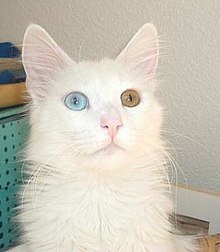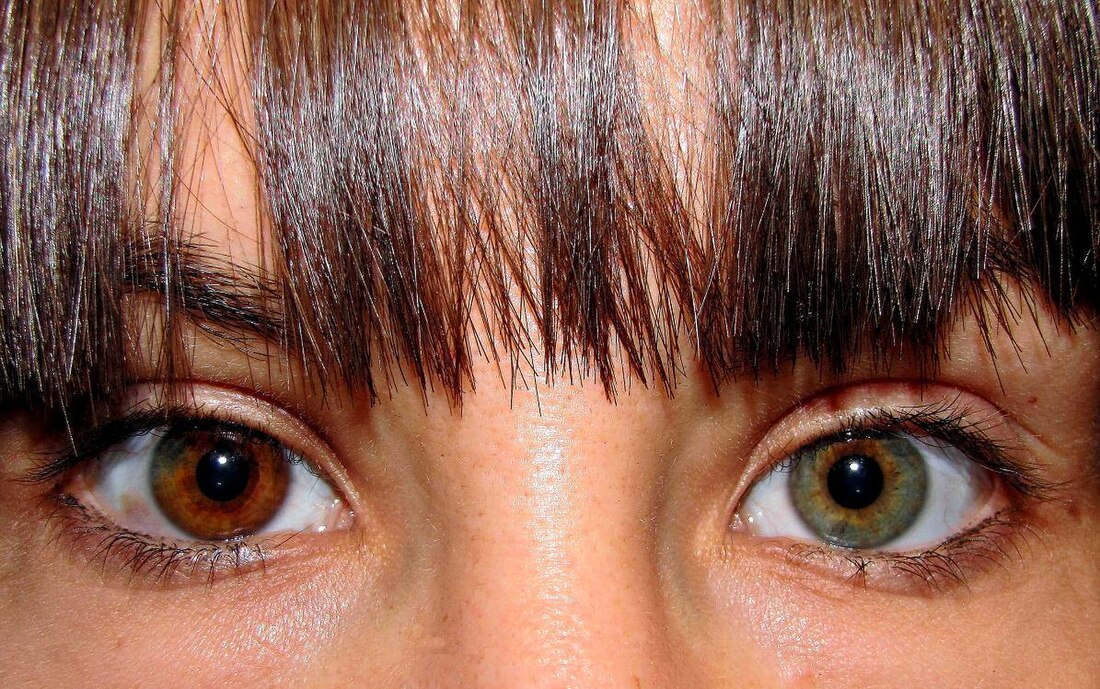Heterochromia is a variation in coloration most often used to describe color differences of the iris, but can also be applied to color variation of hair[1] or skin. Heterochromia is determined by the production, delivery, and concentration of melanin (a pigment). It may be inherited, or caused by genetic mosaicism, chimerism, disease, or injury.[2] It occurs in humans and certain breeds of domesticated animals.
| Heterochromia | |
|---|---|
 | |
| Complete heterochromia iridum | |
| Specialty | Ophthalmology |
| Symptoms | Different or partially different eye color |
| Duration | Lifelong |
| Treatment | Iris implant surgery (controversial for cosmetic purposes) |
Heterochromia of the eye is called heterochromia iridum or heterochromia iridis. It can be complete, sectoral, or central. In complete heterochromia, one iris is a different color from the other. In sectoral heterochromia, part of one iris is a different color from its remainder. In central heterochromia, there is a ring around the pupil or possibly spikes of different colors radiating from the pupil.
Though multiple causes have been posited, the scientific consensus is that a lack of genetic diversity is the primary reason behind heterochromia, at least in domestic animals. This is due to a mutation of the genes that determine melanin distribution at the 8-HTP pathway, which usually only become corrupted due to chromosomal homogeneity.[3] Though common in some breeds of cats, dogs, cattle and horses due to inbreeding, heterochromia is uncommon in humans, affecting fewer than 200,000 people in the United States, and is not associated with lack of genetic diversity.[4][5]
The affected eye may be hyperpigmented (hyperchromic) or hypopigmented (hypochromic).[3] In humans, an increase of melanin production in the eyes indicates hyperplasia of the iris tissues, whereas a lack of melanin indicates hypoplasia.
The term is derived from Ancient Greek: ἕτερος, héteros "different" and χρῶμα, chrôma "color".[6]
Background

Eye color, specifically the color of the irises, is determined primarily by the concentration and distribution of melanin. Although the processes determining eye color are not fully understood, it is known that inherited eye color is determined by multiple genes. Environmental or acquired factors can alter these inherited traits.[7]
The color of the mammalian, including human, iris is very variable. However, there are only two pigments present, eumelanin and pheomelanin. The overall concentration of these pigments, the ratio between them, variation in the distribution of pigment in the layers of the stroma of the iris and the effects of light scattering all play a part in determining eye color.[8] In the United States, July 12 is observed by some as National Different Colored Eyes Day.[9]
Classification

Heterochromia is classified primarily by onset: as either genetic or acquired. Although a distinction is frequently made between heterochromia that affects an eye completely or only partially (sectoral heterochromia), it is often classified as either genetic (due to mosaicism or congenital) or acquired, with mention as to whether the affected iris or portion of the iris is darker or lighter.[10] Most cases of heterochromia are hereditary, or caused by genetic factors such as chimerism, and are entirely benign and unconnected to any pathology, however, some are associated with certain diseases and syndromes. Sometimes one eye may change color following disease or injury.[11][12][13]
Genetic
Abnormal iris darker
- Lisch nodules – iris hamartomas seen in neurofibromatosis.
- Ocular melanosis – a condition characterized by increased pigmentation of the uveal tract, episclera, and anterior chamber angle.
- Oculodermal melanocytosis (nevus of Ota)[3]
- Pigment dispersion syndrome – a condition characterized by loss of pigmentation from the posterior iris surface which is disseminated intraocularly and deposited on various intraocular structures, including the anterior surface of the iris.[medical citation needed]
- Sturge–Weber syndrome – a syndrome characterized by a port-wine stain nevus in the distribution of the trigeminal nerve, ipsilateral leptomeningeal angiomas with intracranial calcification and neurologic signs, and angioma of the choroid, often with secondary glaucoma.[14][15]
Abnormal iris lighter

- Simple heterochromia – a rare condition characterized by the absence of other ocular or systemic problems. The lighter eye is typically regarded as the affected eye as it usually shows iris hypoplasia. It may affect an iris completely or only partially.
- Congenital Horner's syndrome[16] – sometimes inherited, although usually acquired.
- Waardenburg syndrome[16] – a syndrome in which heterochromia is expressed as a bilateral iris hypochromia in some cases. A Japanese review of 11 children with albinism found that the condition was present. All had sectoral/partial heterochromia.[17]
- Piebaldism – similar to Waardenburg's syndrome, a rare disorder of melanocyte development characterized by a white forelock and multiple symmetrical hypopigmented or depigmented macules.
- Hirschsprung's disease – a bowel disorder associated with heterochromia in the form of a sector hypochromia. The affected sectors have been shown to have reduced numbers of melanocytes and decreased stromal pigmentation.[18]
- Incontinentia pigmenti[3]
- Parry–Romberg syndrome[3]
Acquired

Acquired heterochromia is usually due to injury, inflammation, the use of certain eyedrops that damage the iris,[19] or tumors, both benign and malignant.[20]
Abnormal iris darker
- Deposition of material
- Siderosis – iron deposition within ocular tissues due to a penetrating injury and a retained iron-containing, intraocular foreign body.
- Hemosiderosis – long standing hyphema (blood in the anterior chamber) following blunt trauma to the eye may lead to iron deposition from blood products.
- Certain eyedrops – prostaglandin analogues (latanoprost, isopropyl unoprostone, travoprost, and bimatoprost) are used topically to lower intraocular pressure in glaucoma patients. A concentric heterochromia has developed in some patients applying these drugs. The stroma around the iris sphincter muscle becomes darker than the peripheral stroma.[medical citation needed] A stimulation of melanin synthesis within iris melanocytes has been postulated.[21]
- Neoplasm – Nevi and melanomatous tumors.
- Iridocorneal endothelium syndrome[3]
- Iris ectropion syndrome[3][22]
Abnormal iris lighter
- Fuchs heterochromic iridocyclitis – a condition characterized by a low grade, asymptomatic uveitis in which the iris in the affected eye becomes hypochromic and has a washed-out, somewhat moth eaten appearance. The heterochromia can be very subtle, especially in patients with lighter colored irides. It is often most easily seen in daylight. The prevalence of heterochromia associated with Fuchs has been estimated in various studies[23][24][25] with results suggesting that there is more difficulty recognizing iris color changes in dark-eyed individuals.[25][26]
- Acquired Horner's syndrome – usually acquired, as in neuroblastoma,[27] although sometimes inherited.
- Neoplasm – Melanomas can also be very lightly pigmented, and a lighter colored iris may be a rare manifestation of metastatic disease to the eye.
- Parry–Romberg syndrome – due to tissue loss.[28]
Heterochromia has also been observed in those with Duane syndrome.[29][30]
Partial heterochromia – different colors in the same iris
Partial heterochromia is most often a benign trait of genetic origins, but, like complete heterochromia, can be acquired or be related to clinical syndromes.

Sectoral
In sectoral heterochromia, areas of the same iris contain two different colors, the contrasting colors being demarcated in a radial, or sectoral, manner. Sectoral heterochromia may affect one or both eyes.[31] It is unknown how rare sectoral heterochromia is in humans, but it is considered to be less common than complete heterochromia.
Central

Central heterochromia is also an eye condition where there are two colors in the same iris; but the arrangement is concentric, rather than sectoral. The central (pupillary) zone of the iris is a different color than the mid-peripheral (ciliary) zone. Central heterochromia is more noticeable in irises containing low amounts of melanin.[32]
In history and culture
Heterochromia of the eye was first described as a human condition by Aristotle, who termed it heteroglaucos.[12]
Notable historical figures thought to have heterochromia include the Byzantine emperor Anastasius the First, dubbed dikoros (Greek for 'having two pupils'). "His right eye was light blue, while the left was black, nevertheless his eyes were most attractive", is the description of the historian John Malalas.[33][34][35] A more recent example is the German poet, playwright, novelist, scientist, statesman, theatre director, and critic, Johann Wolfgang Goethe.[36]
The Alexander Romance, an early literary treatment of the life of Alexander the Great, attributes heterochromia to him. In it he is described as having one eye light and one eye dark. However, no ancient historical source mentions this. It is used to emphasise the otherworldly and heroic qualities of Alexander.[37][38]
In the Ars Amatoria, the Roman poet Ovid describes the witch Dipsas as having 'double pupils'. Kirby Flower Smith suggested that this could be understood as heterochromia, though other scholars have disagreed. The Roman jurist and writer Cicero also mentions the same feature of 'double pupils' as being found in some Italic women. Pliny the Elder related this feature to the concept of 'the evil eye'.[39]
The twelfth-century scholar Eustathius, in his commentary on the Iliad, reports a tradition in which the Thracian Thamyris (son of the nymph Argiope), who was famed for his musical abilities, had one eye that was grey, whilst the other was black. W. B. McDaniel suggests that this should be interpreted as heterochromia.[40]
In other animals

Although infrequently seen in humans, complete heterochromia is more frequently observed in species of domesticated mammals. The blue eye occurs within a white spot, where melanin is absent from the skin and hair (see Leucism). These species include the cat, particularly breeds such as Turkish Van, Khao Manee and (rarely) Japanese Bobtail. These so-called odd-eyed cats are white, or mostly white, with one normal eye (copper, orange, yellow, green), and one blue eye. Among dogs, complete heterochromia is seen often in the Siberian Husky and few other breeds, usually Australian Shepherd and Catahoula Leopard Dog and rarely in Shih Tzu. Horses with complete heterochromia have one brown and one white, gray, or blue eye—complete heterochromia is more common in horses with pinto coloring. Complete heterochromia occurs also in cattle and even water buffalo.[41] It can also be seen in ferrets with Waardenburg syndrome, although it can be very hard to tell at times as the eye color is often a midnight blue.
Sectoral heterochromia, usually sectoral hypochromia, is often seen in dogs, specifically in breeds with merle coats. These breeds include the Australian Shepherd, Border Collie, Collie, Shetland Sheepdog, Welsh Corgi, Pyrenean Shepherd, Mudi, Beauceron, Catahoula Cur, Dunker, Great Dane, Dachshund and Chihuahua. It also occurs in certain breeds that do not carry the merle trait, such as the Siberian Husky, Dalmatian, and rarely, Shih Tzu. There are examples of cat breeds that have the condition such as Van cat.[42]
See also
References
External links
Wikiwand in your browser!
Seamless Wikipedia browsing. On steroids.
Every time you click a link to Wikipedia, Wiktionary or Wikiquote in your browser's search results, it will show the modern Wikiwand interface.
Wikiwand extension is a five stars, simple, with minimum permission required to keep your browsing private, safe and transparent.
